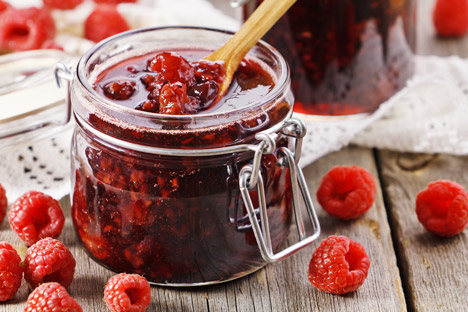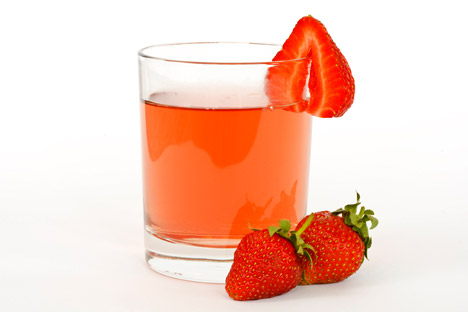
Russian Raspberry Preserves (Varyenie). Source: Lori / Legion Media
{***Berry season in Russia***}
For Anglo Saxons, berry season is synonymous with piecrust and muffin tins. Western Europeans fashion elegant pastries and piquant sorbets from their harvest. The Russians approach berry season in a simpler and more practical two-pronged approach. They consume as many berries as possible, either fresh from the market basket or in the ubiquitous summer berry pudding Kissel’, while working around the clock to make “Russian Penicillin:” the jewel-toned jars of sweet berry jam that preserve summer’s bounty of sweetness and goodness all through the winter ahead.
Kissel’, a distant Slavic cousin to blancmange is possibly Russia’s oldest recorded dessert, and certainly the only one to earn a mention in the venerable Primary Chronicles: playing a major role in the salvation of a besieged 10th Century city. Kissel’ appears in Northern and Eastern European cuisine as both soup and pudding, thickened with arrowroot or potato starch. The difference lies in the amount of liquid added. Fresh berries give kissel’ its tangy flavor and name: from the Russian word “kisliy” meaning, “sour.” The pudding is particularly popular with children, possibly because its bright pastel color is as appealing as its fresh berry flavor. Kissel’ can be made with almost any kind of berry and thus plays a consistently prominent role in the summer dessert line up well into late August.
Jam making in Russia is a very serious undertaking indeed, considered not only a culinary art, but also a medical one. Generations of Russians have staved off starvation, scurvy, rickets, and other diseases thanks to the vitamins they preserve in fruit jam. At the first sign of a cold or flu, Russians brews a cup of tea, crack open a jar of homemade jam and take to bed to recuperate. Jam making always reminds me of Leo Tolstoy who does what master storytellers do so well: he shows more than he tells. In one memorable scene from “Anna Karenina,” Tolstoy shows us the transformation of Princess Kitty Sherbatsky from flighty debutante to contented wife through her preoccupation and dexterity with jam making. Kitty boldly pits her mother’s waterless recipe for jam against that of her new husband’s septuagenarian housekeeper, Agafya Mikhailovna, who advocates adding water. The resulting tense jam-off on the porch of the Levins’ country house knits the scene together, as well as providing readers with a valuable lesson in 19th Century culinary arts.
Kitty’s mom’s method is the one preferred by the gold-toothed ladies at the market stalls I frequent in Moscow. They frustratingly do not go into a lot more detail about how they make their delicious sticky sweet preserves. After many trials and errors, the recipe below from “The Complete Book of Year-Round Small Batch Preserving,” has produced the closest approximation. Commercial powdered pectin is a relatively new introduction to Russia’s market, omitting it keeps the flavor of this jam pure and intense. I keep a jar of raspberry jam in the fridge all year round for all manner of purposes: to add to sauces, as the base for salsa, to top ice cream, or jazz up a cocktail. And when I’m feeling a little worn out, I’ve been known to spoon it directly from the jar. Can there be anything as good as the taste of summer in the middle of winter?
Ingredients:
- 1 liter of fresh raspberries
- 1 liter of caster sugar
- Equipment:
- A canning pot, wide and deep enough to fit four (4) 250 ml jars.
- Four (4) new sterilized 250 ml glass canning or jam jars with new lids or rubber seals.
- Dishtowels
- Funnel
- Plastic gloves (optional but advisable)
- Canning tongs (optional but advisable)
Preparation:
1. Preheat the oven to 120°C (250°F).
2. Fill the canning pot with hot water. Scrub the jars, and funnel thoroughly with hot soapy water and rinse well. Place the jars and funnel in the canning pot and cover them with 2-3 inches of water. Cover and bring to a boil. Sterilize for at least 10 minutes.
3. Pour the sugar into a shallow ovenproof pan and bake in the oven for 15 minutes.
4. Wash the raspberries gently and dry them on wadded paper towels.
5. Place the raspberries in a heavy-bottomed copper, aluminum, or enamel pot over high heat, and bring to a boil. Use a potato ricer or the back of a wooden spoon to mash the berries as they cook. Keep stirring as the berries come to a boil, and then boil hard for 1 minute.
6. Add the warmed sugar to the mixture, return to the boil and cook until the mixture gels (this should happen in about 5 minutes.)*
7. Remove the sterilized jars and funnel from the canning pot with the tongs and place them onto a few folded dishtowels.
8. Bring the canning pot water back to a boil and add the lids or rubber seals. Cover and boil for 5 minutes.
9. Ladle the jam through the sterilized funnel into the sterilized jars. Leave a 1/2 –inch (1 cm) gap at the top of the jar. Use a clean, damp dishtowel to wipe the wipe the jar rim thoroughly, making sure there is no residue on the rim of the jar.
10. Remove the lids or rubber seals from the canning pot with tongs. Allow to cool slightly. At this point, you may wish to put on a pair of plastic surgical gloves to ensure that your jam remains bacteria free.
11. Center the lid or rubber seals over the top of the jar and apply top to secure.
12. Place jars on the canning pot’s rack or a few folded dishcloths placed at the bottom of the pot. Arrange the jars so that they do not touch one another and there is plenty of room for water to circulate between them. Add water to cover jars by 1-2 inches (2.5 to 5 cm). Cover and bring water to a boil. Process for 5 minutes.
13. Remove jars from the canning pot with tongs and place on a folded dishcloth. DO NOT place them directly on your counter or they will crack and all your hard work will be spoilt!
14. Let cool for 24 hours. Store in a cool, dark place – for best results, store in fridge.
To test the doneness of jam, place a spoonful of jam on a plate and place it in the freezer for 1 minute. Remove from the freezer. If the surface wrinkles when pushed with the back of a spoon, the jam is done. If not, keep cooking and repeat the test each five minutes.
{***How to prepare Kisel***}

Kisel. Source: Lori / Legion Media
Equipment:
- Mould: Kissel’ can be chilled in one large mould, a simple glass bowl, or several small pudding dishes. Because the color is so appealing, glass makes the best presentation. For entertaining, I serve kissel’ in small wine glasses and top it with a layer of whipped cream and a garnish of fresh berries. Any way you mould it, kissel’ is sure to please!
- Food mill or fine sieve
Ingredients:
- 500 ml (2 cups) of fresh mixed berries, washed and hulled
- 1-1/4 liters (5 cups) of water
- 45-60 ml (3-4 Tablespoons) of sugar
- 60 ml (4 Tablespoons) of strong liqueur such as Grand Marnier
- 60 ml (4 Tbl) of potato starch or (if you are in Russia) specially packaged “Kissel’” mix.
Instructions:
1. Bring the berries and 1 liter (4 cups) of the water to a boil over medium high heat in a heavy-bottomed saucepan or Dutch oven. Reduce heat and let cook until the berries begin to loose their shape (up to 15 minutes).
2. Cool slightly so that the mixture is lukewarm. Sieve the berries through a food mill or fine sieve, using the end of a wooden spoon to extract as much juice as you can.
3.Combine the berries, liqueur, and liquid in the pot with the sugar. Taste and adjust sugar, adding sugar by the teaspoon as needed to achieve the desired taste. Bring to a boil and stir over medium heat. Reduce the heat to low and simmer until the sugar is completely dissolved (up 3 minutes.)
4. In a non-reactive bowl, whisk the kissel’ mix or potato starch with the remaining cup of water, taking care that there are no lumps.
5. Whisk the kissel’ mix into berry mixture, stirring constantly until the mixture thickens and clings to a wooden spoon as you lift it from the pot.
6. Remove the pot from the heat and let cool to room temperature. Divide the mixture into moulds or pudding glasses and refrigerate overnight.
**This recipe from Anya von Bremzen’s “To The Table” for kissel’ is the best of many I have tried over the years.
Priyatnogo Appetita!
All rights reserved by Rossiyskaya Gazeta.
Subscribe
to our newsletter!
Get the week's best stories straight to your inbox